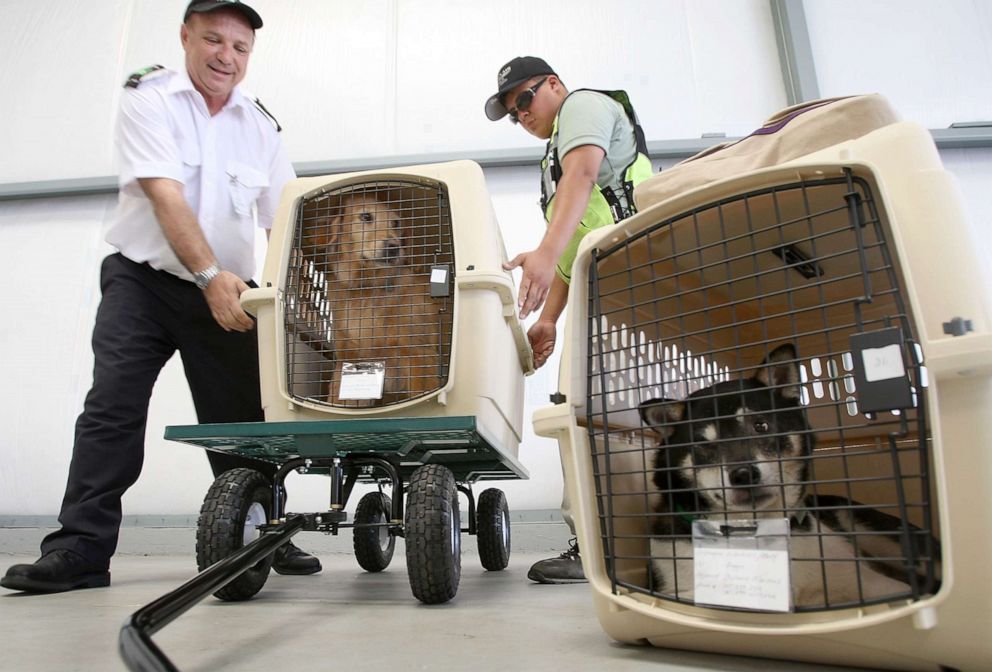What pet owners needs to know about flying with their dogs
Everything you need to know about flying with your dog.
Booking a plane ticket it’s often as simple as the click of a few buttons -- except when flying with your dog.
Then, this relatively simple process becomes a bit more complicated due to specific rules, restrictions and regulations put in place in order to ensure your dog’s safety.
But, if you prepare in advance, traveling with your pup should be a breeze.
“It’s essential to think ahead and not finalize travel plans till the last minute,” says Dr. Rachel Barrack, a veterinarian specializing in acupuncture and Chinese herbology, and the founder of the concierge practice Animal Acupuncture in New York City.
Because of unforeseen circumstances, like the weather, pet embargo rules are put in place for a dog’s safety. Check with your carrier to find out their temperature and destination restrictions.
Most airlines will not allow dogs to fly if the current or forecasted temperature is above 85 or below 45 degrees. American Airlines, for example, prohibited checked pets from traveling to, through or from Phoenix, Tucson, Las Vegas or Palm Springs between May 1 and Sept. 20, 2019.
Before you book your four-legged friend’s airline ticket, we’ve gathered up a few important tips to ensure a safe flight.
Visit your vet
First, your dog must be healthy enough to travel.
All vaccinations have to be up-to-date and a health certificate, along with proof of those vaccinations, will need to be provided to the airline.
“The health certificate is only valid for 30 days and will be required for both the departure and return flights,” Dr. Barrack explained.
If traveling internationally, check to see if the country has any additional restrictions or regulations. For example, Mexico requires that documentation be written in both English and Spanish, and upon arrival, a brief physical examination will be conducted in order to verify your dog is in compliance with their requirements.

Cabin versus cargo area
Before booking, check with the airline to determine if your dog will be allowed to fly in the main cabin.
Your vet can then advise you as to whether your dog is healthy enough to travel in either the cabin or cargo area. Dogs with pre-existing cardiac, respiratory, epilepsy, blood clots, hypertension and other issues, as well as very young, pregnant or elderly dogs may be advised against flying entirely.
Dogs traveling in the pressurized cargo compartment will need to be in a secure crate. Dr. Barrack suggests using zip ties to ensure the crate cannot be opened and that your dog is unable to escape. The crate should be marked “live animal” with your pet’s name, address, contact information and destination details. Clip on a water bottle to the outside so it can’t be knocked over. Remove collars prior to departure so there are no strangulation hazards.
If traveling in the main passenger cabin, dogs must be confined in a carrier (check with the airline on specific measurements) and placed beneath the seat in front of you -- never in the overhead bin, Dr. Barrack insists. On most airlines, a pet carrier takes the place of one carry-on and a fee may apply.
Certain types of dogs, especially brachycephalic (short nosed) breeds like the Bulldog, Boxer and Pug, are more likely to have respiratory issues and have difficulty breathing. “These types of dogs should never fly in cargo,” she said.
Avoid layovers
No one likes a layover and it’s even harder for your dog. When planning your travel, direct flights are always best to minimize total travel time.
Inquire with the airline as to whether they have a limit on the number of pets allowed per flight. Delta has a first-come, first-serve basis and passengers must call in advance to arrange to bring a pet on-board. There’s nothing worse than getting to the airport only to find out your pup must travel on another flight.
Risks with sedation
Regardless of where your dog stays during the flight, Dr. Barrack advises against sedation. Sedatives increase the risk of cardiac and respiratory issues due to the changing of altitude and pressure, making it harder for a dog to thermoregulate. If you choose to sedate your dog, you’ll need to let check-in personnel know the name of the medication, the amount, and date and time it was taken as a safety precaution.
Helpful things to bring
Your dog might not need clothing but he sure needs a few things “packed” for the trip:
Ample food, treats and toys goes without saying, but make sure to bring any medications and/or supplements in your carry-on bag.
Research 24/7 emergency vet clinics and veterinarians in the area you’ll be staying, just in case.
A properly tagged collar or harness along with leash should be included in your dog’s travel bag.
Meal time
Traveling on an upset stomach is never pleasant and that goes for your dog as well. While you don’t want to offer a large meal right before takeoff, Dr. Barrack recommends feeding at least four hours prior to travel. This will ensure your dog isn’t flying on a full stomach and has had time to digest and relieve himself.
Water on the other hand can be given throughout the trip.

Play time
There's an old saying, “a tired dog is a good dog.”
Long flights can be tedious so before heading to the airport, schedule some playtime to help release some energy.
Charles “Chick” Gregg, co-owner and pilot for Air-Unlimited, often flies with his Golden Retriever Bria, and makes sure to carve out time for a game of fetch which he says tires her out.
Stay calm
Flying can be stressful, even for the calmest of humans and canines. Airports are chaotic and because dogs are highly attuned to the energy around them, it’s important to stay calm and avoid adding to an already stressful situation.
Safe travels!






